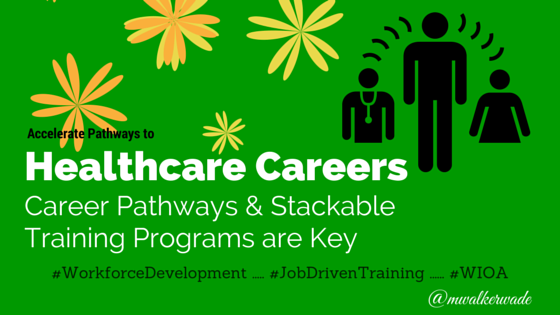Creating Accelerated Career Pathways into Healthcare
 According to Manpower’s 2015 Talent Shortage Survey (#TalentShortage), nursing occupations is #7 on a list of 10 industries. For survey purposes, nurses includes:
According to Manpower’s 2015 Talent Shortage Survey (#TalentShortage), nursing occupations is #7 on a list of 10 industries. For survey purposes, nurses includes:
Non-degree: CMAs, PCAs, CNAs, HHAs, LPNs, and LVNs
Degreed: RNs
Advanced degree: APNs, NPs, PAs, CLNs, CNSs, CNMs, CRNAs
According to Stephanie Neuvirth, chief human resources and diversity officer at City of Hope in Duarte, CA:
“Jobs in accounting, finance, IT and administration are plentiful in health care. Although these jobs provide the infrastructure for the health care industry, parents, guidance counselors and students don’t realize they exist.”
Career fields such as healthcare, especially where patient contact is key, are challenging to fill because success depends on having the right combination of soft skills, technical skills, and physical ability. Certain roles in health care also needs individuals who are able to relate to the cultural and spiritual norms of the patient. Healthcare providers in Duarte, CA understand this challenge all too well, as 71% of their patients are Hispanic.
“Only 6 percent of the physicians and 8 percent of the nurses in the U.S. are Hispanic”
When I look across the landscape of career education, I see many schools providing training in allied healthcare, yet employers still struggle to get the type of employee they really need. It’s clear that the typical training program is not quite hitting the mark. In some cases the problem is the curriculum, in other cases the problem is access to internships, but in some cases (and I hate to say this) it’s the student. I’ve had first-hand experience on numerous occasions where a student wanted to join my healthcare training program because “there’s a lot of jobs in healthcare”. As a program manager, if your primary concern was getting enough students enrolled into the course to meet your revenue target, it may be easy to fill your class with students who can do the technical skills of medical care, but who lack the genuine compassion for patient care. These type of students will ultimately be fairly unemployable in the healthcare industry. As workforce development planners and education & training providers I believe this is something that deserves our consideration.
There are three programs making an impact on suring-up our need for qualified and quality health care talent I’d like to share with you:
CareerSTAT is “an initiative to document and endorse the business case for investments in frontline hospital workers and to establish an employer-led advocacy council to promote investments that yield strong skill development and career outcomes for low-wage, frontline hospital workers”. Nearly 100 health care organizations partner with CareerSTAT including Kaiser Permanente and Banner Health. Some of their activities include:
- An employer-led national collaboration of health care leaders
- A clearinghouse for best practices in health care and shared information in training development
- A focus on early college and career pathway programs and provides low-income and minority students with access to in-demand health care careers
- Work towards initiatives that would get Hispanic youth engaged in health care careers
TEACH Project (Train, Educate, and Accelerate Careers in Healthcare)- seeks to create skilled workers in health IT. This project works with high-school students to provide education, training and job shadowing opportunities, integrated with their current school studies. Students concurrently receive high-school credit, community college credit, and on the job experience that accelerates their entrance into a job in the medical field.
Homebridge, Inc in San Mateo, CA – One of the most advanced employer-based, entry-level training programs into the medical field. The Homebridge training program provides adult-centered, competency- based training curriculum, designed to be accessible to students with a minimum of 6th grade proficiency. The training highlights the value of hands-on learning and includes a simulation apartment where caregivers can practice with beds, wheelchairs, and bathroom facilities. Success in the classroom is supported in the field by peer mentors who provide on- the-job training and a work-life coach who addresses barriers to job retention. Because of their strong emphasis on training & development, Homebridge’s 37% turnover rate for frontline caregivers is 31% lower than the 54% national average.
As workforce developers and education & training providers move forward with WIOA (Workforce Innovation & Opportunity Act) implementation activities, I believe programs like these give great models to emulate, but more so, some good starting points for finding the right kind of partnerships. Remember, partnerships and “stackablity” are key components to a successful WIOA funded program.
This article is based on my own research, therefore I have no endorsement of any kind from these three programs. If you’d like to read more about them you’ll find articles at these two links.
CareerSTAT & TEACH – http://tinyurl.com/p8vjymn
Homebridge, Inc: http://tinyurl.com/o88rjsf


Reblogged this on fredeflux's Blog.